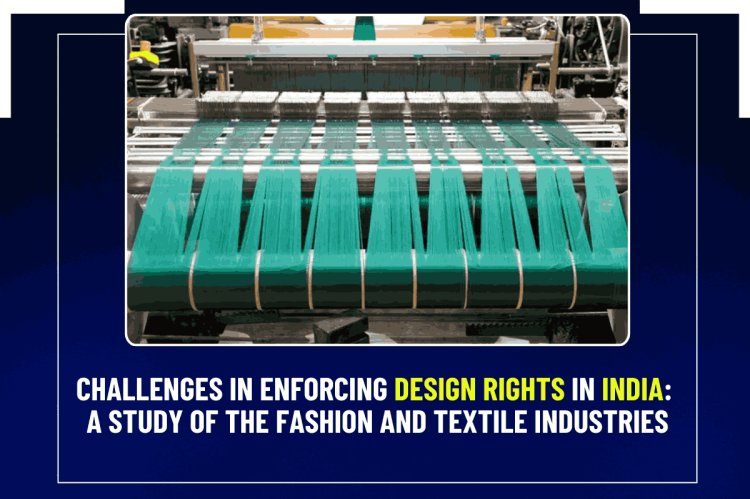Challenges in Enforcing Design Rights in India: A Study of the Fashion and Textile Industries
The fashion and textile industries in India thrive on innovation, creativity, and design originality. However, enforcing design rights in these industries is fraught with challenges. From lengthy registration processes to widespread design piracy and limited legal remedies, the system often leaves designers and businesses vulnerable to infringement. This blog explores the unique challenges faced by stakeholders in enforcing design rights within the Indian fashion and textile sectors. It examines the legal framework, key enforcement issues, and suggests reforms to strengthen protection in this dynamic industry.

Introduction
India’s fashion and textile industries are globally recognized for their craftsmanship, creativity, and rich cultural heritage. However, one of the critical issues plaguing these industries is the difficulty in enforcing design rights. While fashion and textile designs represent a substantial portion of the industry's value, the ability to protect these designs through legal mechanisms is often limited.
With design piracy rampant and a legal framework that is often slow and inefficient, designers and businesses face significant obstacles when trying to protect their creative work. In this blog, we explore the challenges specific to the enforcement of design rights within the fashion and textile sectors in India, discussing the legal framework, real-world challenges, and potential solutions for better protection.
Legal Framework for Design Rights in India
In India, design rights are governed by the Designs Act, 2000. This legislation provides protection for the aesthetic features of industrial articles, such as their shape, configuration, pattern, or ornamentation. A registered design under the Act provides exclusive rights to the owner for a period of 10 years, which can be extended for an additional 5 years.
For the fashion and textile industries, this law is particularly relevant in protecting unique fabric patterns, embroidery designs, and garment shapes. However, while the legislation offers the promise of protection, enforcing these rights is often an arduous process.
Challenges in Enforcing Design Rights
A. Lengthy Registration Process
One of the primary challenges in protecting designs in the fashion and textile industries is the lengthy registration process. In India, it can take several months for a design to be registered under the Designs Act. During this period, designers are left vulnerable to copying and piracy, which are rampant in the fashion industry where trends change rapidly.
For example, a designer who creates a new lehenga pattern may find that by the time the design is registered, imitations have already flooded the market, making the legal protection almost redundant. The slow process undermines the very purpose of design registration, which is to provide timely protection to innovative works.
B. Lack of Awareness Among Designers
Another significant challenge is the lack of awareness among designers and small businesses about their design rights. Many creators in the fashion and textile sectors are unaware of the need to register their designs to gain legal protection. This lack of awareness is especially prevalent among small and medium enterprises (SMEs) and independent designers, who may not have access to legal counsel or resources for design registration.
C. Widespread Design Piracy
Design piracy is a rampant problem in the fashion industry, where counterfeiters and competitors often copy unique designs and sell them at lower prices. This is particularly prevalent in India, where large unorganized sectors of the fashion industry operate with little oversight.
For instance, a well-known designer may release a sari collection, only to find cheap imitations available in local markets within weeks. Enforcing design rights in such cases becomes extremely difficult, especially when dealing with small-scale counterfeiters who operate in fragmented, informal sectors.
D. Limited Legal Remedies
While the Designs Act offers protection, legal remedies for design infringement are often limited. Designers can file for damages and injunctions to stop the infringing use of their designs, but the legal process is slow, expensive, and uncertain. Many independent designers and small businesses do not have the financial resources to pursue lengthy court battles.
Moreover, the penalties for design infringement in India are relatively weak compared to other jurisdictions, offering little deterrence for counterfeiters who profit from copying original designs.
E. Difficulty in Proving Infringement
Another challenge in enforcing design rights is the difficulty in proving infringement. The fashion industry is inherently creative, with designers often drawing inspiration from traditional motifs or global trends. This makes it difficult to distinguish between legitimate inspiration and outright copying.
For example, if two designers use similar embroidery patterns, one might claim that the other has infringed upon their design, but proving that the design was stolen rather than inspired by common cultural elements can be a grey area in Indian courts.
Case Studies: Fashion and Textile Design Piracy in India
Case 1: The Sabyasachi Mukherjee Case
One of India’s most celebrated designers, Sabyasachi Mukherjee, has been a victim of design piracy on multiple occasions. His intricate lehenga designs, which are priced at a premium, have often been copied and sold in the market at lower prices. Although Mukherjee has taken legal action in several cases, the time-consuming legal process often means that counterfeiters continue to profit from his designs long after the case has been filed.
Case 2: Satya Paul vs. Pirated Designs
In the famous case of Satya Paul, a leading Indian fashion brand, the company took legal action against several smaller retailers for copying its distinctive sari designs. While the courts granted injunctions in favor of Satya Paul, the process took months, during which the infringers had already made significant profits from the counterfeit saris.
These cases highlight the limitations of enforcement mechanisms in India and the need for quicker, more effective remedies for design infringement in the fashion and textile sectors.
5. Solutions and Reforms: Strengthening Design Protection
To address the challenges in enforcing design rights in India’s fashion and textile industries, several reforms are necessary:
A. Streamlined Registration Process
The design registration process should be streamlined to allow for quicker and more efficient protection. Reducing the registration time from several months to a few weeks would give designers faster protection, allowing them to bring their creations to market without fear of piracy.
B. Greater Awareness and Education
There needs to be a concerted effort to raise awareness among designers and businesses about the importance of design registration. Educational programs, workshops, and online resources should be made available to help designers, particularly SMEs, understand the legal protections available to them and how to enforce their rights.
C. Stronger Penalties for Infringement
To deter design piracy, stronger penalties should be imposed for design infringement. Increasing the financial damages awarded to victims of design theft and imposing criminal penalties on counterfeiters could act as a significant deterrent.
D. Specialized IP Courts
India could benefit from establishing specialized IP courts that handle design infringement cases more efficiently. This would ensure that cases involving design rights are dealt with by judges who have specific expertise in intellectual property law, speeding up the legal process and improving outcomes for designers.
E. Encouraging Licensing and Collaboration
One way to reduce the incidence of design piracy is to encourage licensing agreements between designers and manufacturers. By working together, designers can legally license their designs to businesses, allowing them to profit from their creations without fear of infringement.
Conclusion
Enforcing design rights in India’s fashion and textile industries is fraught with challenges, from lengthy registration processes and rampant piracy to limited legal remedies. However, by implementing reforms such as streamlining the registration process, raising awareness, and imposing stronger penalties, India can provide better protection for its designers. The fashion and textile industries are integral to India’s cultural and economic fabric, and ensuring robust design protection will foster creativity and innovation in these sectors.
With more efficient enforcement mechanisms, designers and businesses will be empowered to protect their intellectual property, allowing them to thrive in a competitive marketplace.












